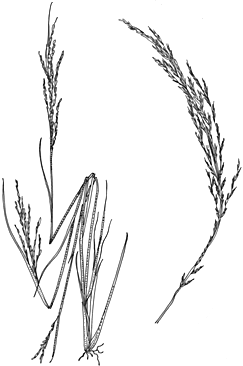Common Name: Beetle grasses

Description: Tufted perennials or annuals; culms erect, drooping in the upper part, nodes prominent, smooth.
Leaves with ligule membranous, sometimes jagged or reduced to a rim; blade flat or involute.
Inflorescence with many spike-like racemes arranged along a central axis (occasionally racemes branched).
Spikelets solitary, shortly pedicellate, dorsally compressed, rachilla disarticulating above the glumes and between the lemmas; florets, bisexual, numerous, somewhat overlapping, disarticulating above the glumes and between the lemmas. Glumes unequal, membranous, keeled, 1-nerved, shorter than the lemmas. Lemmas membranous, 2-fid, minutely notched or sometimes almost truncate, 3-nerved, very shortly awned or mucronate from below the apex or from the notch, sometimes only apiculate, usually finely ciliate on the lower part of the nerves. Paleas shorter than the lemmas, 2-keeled, the keels hairy.
Distribution and occurrence: World: c. 18 species, tropical & subtropical regions, often growing in or near water. Australia: 3 species (2 species native, 1 species naturalized), all mainland States.
Diplachne is sometimes included in Leptochloa but, at least in Australia, the genera appear quite distinct. Key from Wheeler et al. (1990).
Text by S. W. L. Jacobs & K. L. MaClay
Taxon concept:
| | Key to the species | |
| 1 | Spikelets usually less than 8 mm long with 5–7 florets; distinctly pedicellate | 2 |
| Spikelets 8–21 mm long with 8–14 florets, often subsessile; inflorescence branches not divided (the following species may not be distinct) | 3 |
| 2 | Lemmas 2.5 mm long or more; upper glume more than 2 mm long, lower more than 1.5 mm | Diplachne parviflora |
| Lemmas 2.5 mm long or less; upper glume less than 2 mm long, lower less than 1.5 mm long
Back to 1 | Diplachne uninervia |
| 3 | Lemmas 3.5–5 mm long, convex on the back with the palea concave; spikelets usually dark-coloured | Diplachne fusca |
| Lemmas 4.5–6 mm long, the lemmas and paleas almost flat; spikelets dark at first, becoming pale with age
Back to 1 | Diplachne muelleri |
|


